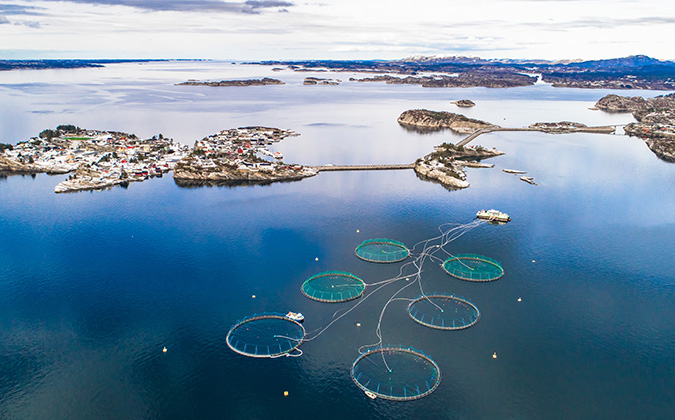
Cage modifications can help manage sea lice problems — but care needed
Sea lice are one of the primary problems affecting Atlantic salmon farming, with severe infestations impacting fish health and performance, and the stress of treatments being linked with the development of other diseases. Changes to the sea cages that salmon are often farmed in offers one solution, according to an expert.
Frode Oppedal, PhD, of the Institute of Marine Research, has been studying the effects of cage modifications on lice for a number of years. He believes that finding ways to create a “mismatch” between fish and lice larvae, which live near the surface of the water, is key to reducing the severity of infestations.
This can be achieved using lice shielding skirts; snorkel cages, which prevent fish swimming to the surface; and submerging the fish to swim deeper, he told an audience at the North Atlantic Seafood Forum in Bergen.
“We did quite a few experiments, and we saw that while keeping the fish close to the surface, they’ll get a lot of lice. If you encourage the fish to swim just 4 or 5 meters deeper, then they got one-third [of the lice], and the deeper you went the less lice they got,” Oppedal said.
A range of options
Luring salmon deeper using feed and light can generally achieve lice reductions of 30% to 40%, he said, while skirts tend to achieve 30% to 70% reductions. Snorkel cages have demonstrated 80% reductions, while in some cases, submergence has resulted in almost 100% control.
Regarding the large variability of performance of skirts, site environmental conditions have a significant impact, he noted. Locations with strong waves often result in decreased effectiveness.
More than 300 skirts are sold per year, but care is needed to get the best from the technology, he said. Stagnant water inside the skirts can result in fish using up oxygen. While this is a problem which can be eased by aerating the cages from below, this can create density differences in the cages, which may deform and pull up the skirts.
Fish’s needs require creative submergence solutions
The challenge with submerging salmon at sea to avoid lice is the fish’s need to fill their swim bladder at the surface, he noted. Without surface access, this empties in 2 to 3 weeks. A trial using weekly submergence showed positive results but needs to be replicated at commercial scale for farmers to have full confidence in this approach.
Submergence with an air dome has also been tested by Oppedal’s team, giving the fish access to around 10cm of air above the surface.
“The swim-bladder fullness was okay throughout the production cycle. The surface activity was within normal ranges, and the swim speed did not go up, as we normally see when they’re not refilling,” he said.
Cages with air domes are rising in popularity, with a number now fully operational and more companies interested in the products. However, environmental suitability is crucial when considering submergence.
Oppedal pointed to a study in the Norwegian fjords, which exposed fish to large temperature differences and low oxygen levels, causing greater prevalence of other disease and mortalities. Performance was better at coastal sites which were not subject to such extremes.
Moving to large, offshore cages may be another tempting solution to avoid sea lice, but he urged producers to show caution, noting studies showing reduced oxygen in large offshore cages to a point that fish welfare could become affected. Such welfare considerations need to be considered in the quest to sustainably farm larger amounts of salmon, he added.






